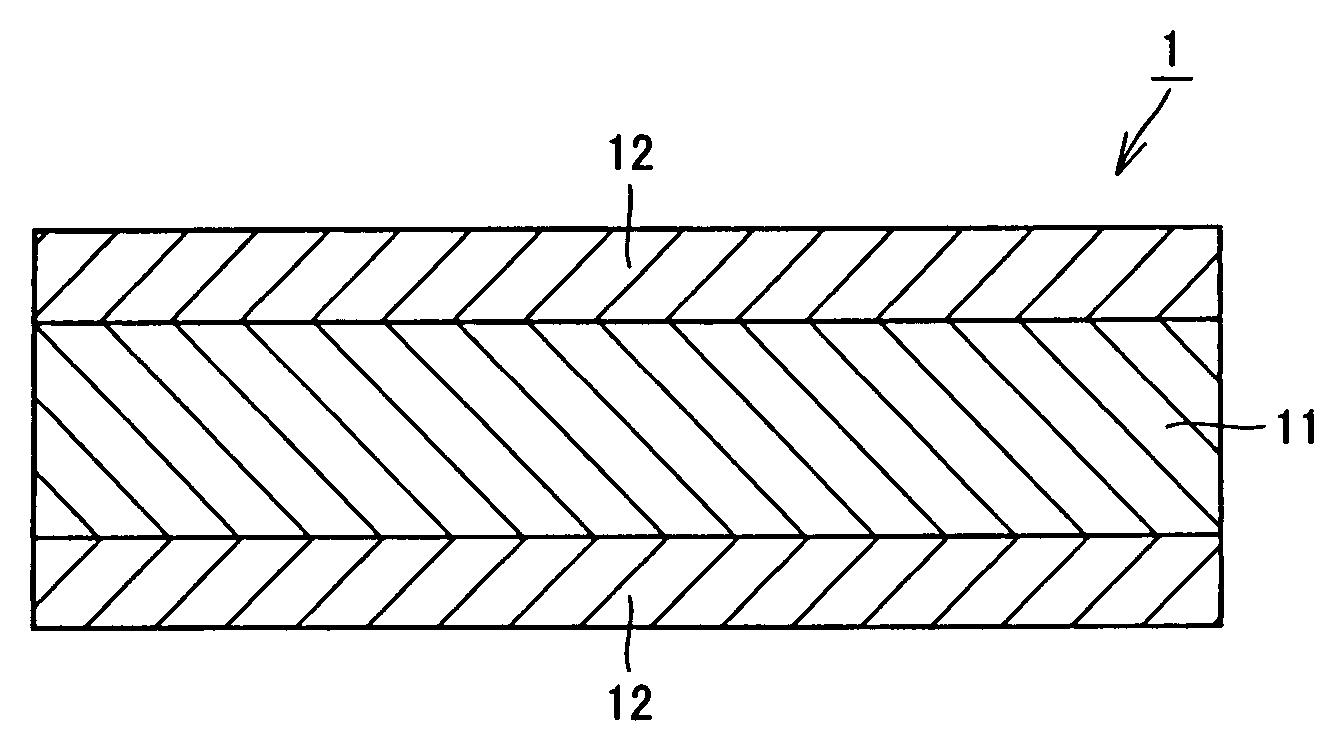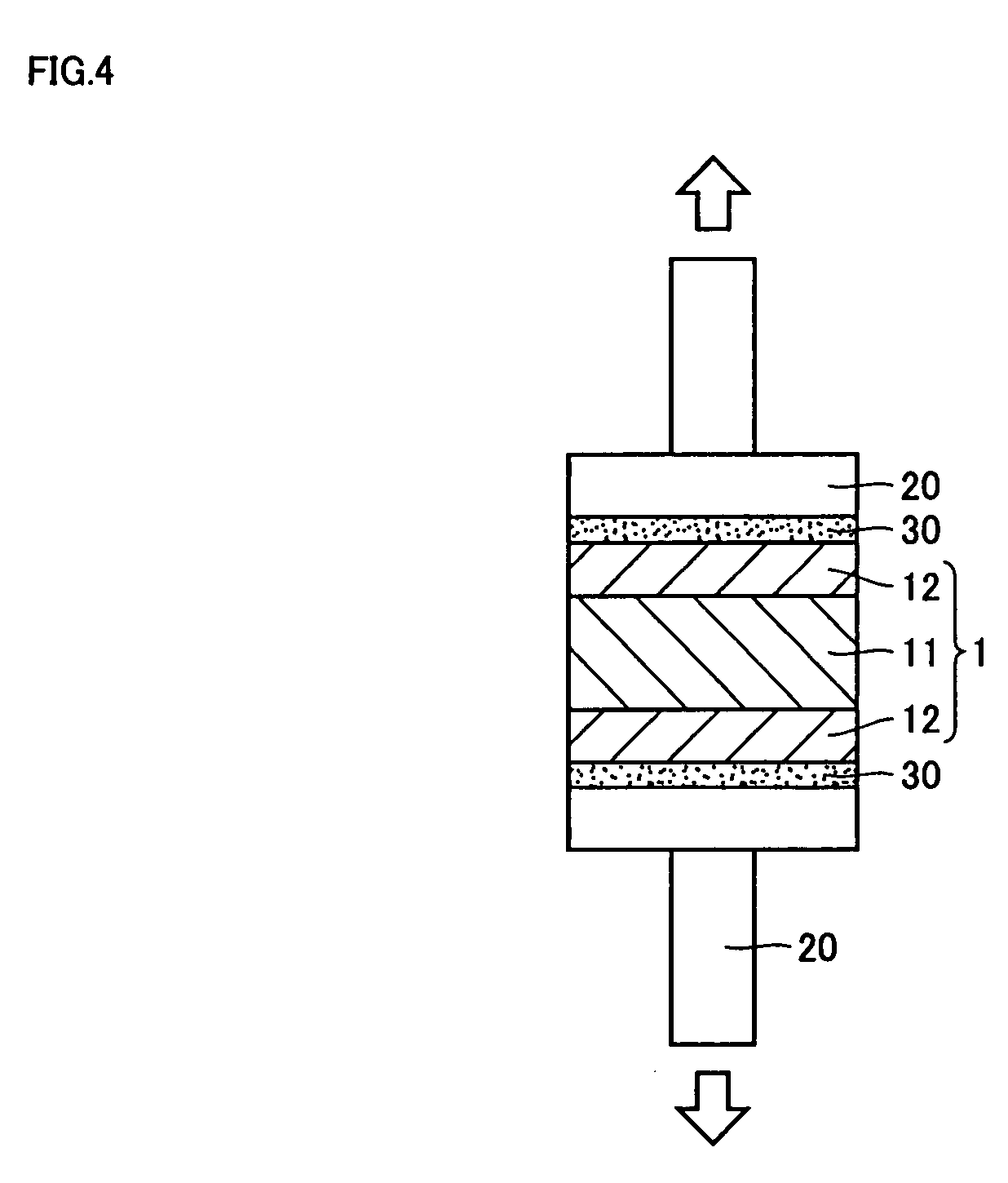Member for Semiconductor Device and Production Method Thereof
- Summary
- Abstract
- Description
- Claims
- Application Information
AI Technical Summary
Benefits of technology
Problems solved by technology
Method used
Image
Examples
example 1
[0114]Aluminum (Al) powder having an average particle diameter of 10 μm and silicon carbide (SiC) powder having an average particle diameter of 15 μm were mixed so that the content of SiC was as shown in Table 1 while the mixing ratio was varied, and molding was carried out while the resultant mixed powder was placed on the top and bottom faces of an aluminum plate of JIS (Japanese Industrial Standards) 1050, or in other words, in the condition that the mixed powder was sandwiched by an aluminum plate having a thickness shown in Table 1, to prepare a molded body (molding step). Molding of mixed powder was carried out so that the molding pressure was 2 ton / cm2 (2×98 MPa) by applying a load of 72 tons on the powder using 100-ton pressing machine. The molded body obtained in this manner was heated and compressed while it was heated to a temperature of 600° C. so that compression pressure was 2 ton / cm2 (2×98 MPa) by application of a load of 72 tons on the molded body with the use of the...
example 2
[0137]Each sample in Example 1 was drilled while lubricant oil was applied to form a hole of 10.5 mm in diameter by means of a drill, and a bolt of M10 was inserted, and a nut was fastened at a torque of 10 kgf in (98 N·m). Breaking occurred in comparative examples 5 to 7, while breaking was not observed in inventive examples 5 to 7 even torque was elevated to 15 kgf·μm (15×9.8 N·m). The crystal structure of an aluminum layer serving as a superficial layer in inventive examples 5 to 7 was observed, and the average crystal particle diameter was 84 μm, 158 μm, and 34 μm, respectively.
example 3
[0138]Samples was prepared in a similar manner as in Example 1 at an SiC content of 60% by mass, with variable the average particle diameter of SiC powder of 5 μm, 10 μm, 80 μm, 150 μm and 200 μm, and a variable thickness of an aluminum layer of 0.050 mm, 0.100 mm, 0.500 mm, 1.000 mm, 2.000 mm, and 2.500 mm. Each sample was evaluated for heat conductivity at a temperature of 100° C., variation in a thickness of an Al layer, and ratio of warp in the same manner as described in Example 1. The results are shown in Table 2, Table 3 and Table 4.
TABLE 2Heat conductivity [W / m · K]SiCaverageparticlediameterThickness of Al layer [mm][μm]0.0500.1000.5001.0002.0002.50051811821801821831871018720620020320120080186198183185198201150185200200205198210200190190190198197205
TABLE 3Variation in thickness of Al layer [%]SiCaverage particleThickness of Al layer [mm]diameter [μm]0.0500.1000.5001.0002.0002.50051098543103015121063804020151273150552518148420080362520146
TABLE 4Ratio of warp (Y / X) [%]SiCavera...
PUM
| Property | Measurement | Unit |
|---|---|---|
| Temperature | aaaaa | aaaaa |
| Fraction | aaaaa | aaaaa |
| Fraction | aaaaa | aaaaa |
Abstract
Description
Claims
Application Information
 Login to View More
Login to View More - Generate Ideas
- Intellectual Property
- Life Sciences
- Materials
- Tech Scout
- Unparalleled Data Quality
- Higher Quality Content
- 60% Fewer Hallucinations
Browse by: Latest US Patents, China's latest patents, Technical Efficacy Thesaurus, Application Domain, Technology Topic, Popular Technical Reports.
© 2025 PatSnap. All rights reserved.Legal|Privacy policy|Modern Slavery Act Transparency Statement|Sitemap|About US| Contact US: help@patsnap.com



